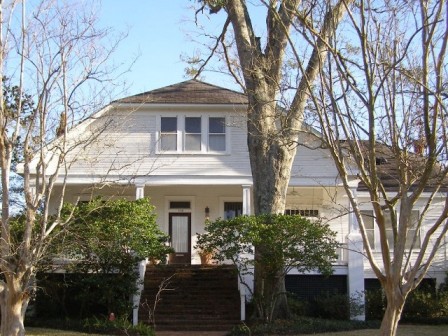 The John A. Texada House (Circa 1914) Owner: Jean Marie Rasbeary
The John A. Texada House (Circa 1914) Owner: Jean Marie Rasbeary
101 Grove was designated a historical landmark during the 1991 evaluation procedure by the Calcasieu Historical Preservation Society.
In a "Local Landmarks" article in Jan of 1992, the home was termed "a big 'raised cottage style' structure." At that time, the owners were Mercedes Plauche and James R. Nieset. The home has since had other owners, including long-time preservationist, Virginia and Patrick Webb who sold to current owner, Jean Marie Rasbeary.
Records indicate that the home was built by lumber yard operator, John Texada in about 1914. He lived in the home until 1924 when he sold it to the Branch Moses family, who lived in the home 50 years until the Niesets bought it in 1974.
The house is located on Lots 1 and 2 of Block 5 of Margaret Place. Research by then-owner and attorney James Nieset indicates that "individual private owership of Lot 1, following creation of the subdivision known as Margaret place was first obtained by John A. Texada, Jr., by purhcase on July 24, 1913. The abstract of title contains neither a mortgage at purchase nor a subsequent mortgage to Mr. Texada toconfirm construction of the residence. "
The 1914 Sanborn Map shows the original house located on Lot 1. The records suggest that the house was built sometime between July, 1913 and the end of 1914.
In a letter to the Landmark Committee on April 9, 1991, Nieset wrote, "The original structure had a wide porch across the front and down the south side of the house. It was built close to the line between Lot 1 and Lot 2. A "bedroom wing" additon was made to the house sometime after the original construction. It could not have been made before the owner acquired Lot 2. The records show that in 1924, Branch Moses bought the existing house and Lot 1 and unimproved Lot 2. The 1925 Sandborn Map shows the house with the "bedroom wing" addition located on Lots 1 and 2. Thus the addition must have been built in 1924 or 1925."
Nieset also commented in his 1991 letter that "We have not uncovered any photographs of the hosue before the modifications. As far as we can tell, the house in its present condition is substantially the same as after the additon of the "bedroom wing."
In addition to the Raised Cottage style, and built on piers approximately 6 feet off the groud surrounded by wooden lattice, Nieset points out these other features:
- The beams and floor joists are yellow heart pine
- The interior features several rooms of edge grain pine floor laid in an interesting carpenter pattern. The interior trim is Louisiana cypress and the trim in the living room and dining room features panels of curly cypress.
- The structure originally featured an eight-foot wide porch all the way across the front and all the way down one side. When the "bedroom wing" was added, part of that porch was enclosed. The wing was added in such a way that it appeared to be of original construction.
- The house contains a "second story" completely enclosed uinder the roof. The gabled ends of the roof have an unusual "flattening."
- The home is built on six-foot piers with wooden lattice work between. The structure sports the original feature of a wide porch across the front and down one side, where part of the porch is enclosed with the addition of a bedroom wing.
Anecdotal Information:
Branch Moses and his wife, Ida Keith Moses, lived in the house from 1924 until the death of Mr. Moses in 1930. Mrs. Moses and the children continued to live in in the home and in 1936, she married a family friend, J. Rufus Greeen. He died several years later, but she and various members of her family continued to live in the house until the Niesets bought it in 1974.
"When the house was originally built," wrote Nieset, "much of the second story was a large ballroom. There have been several stories in the "50 years ago Today" column in the newspaer about dances in the upstairs ballroom." The Nieset's had spoken to several people who attended parties there as children.
During World War II, the upstairs was partitioned off into rooms or apartments that were rented to local servicmen. After the war, one of the children lived in the upstairs apartment.
As part of the Margaret Place Memory and Photo Project to celebrate the 100th Anniversary of Margaret Place, Harcourt Stebbins submitted No Car? No Problem! describing the time he, Alvin Dark, and others lived in the house. He writes that in 1946, "there was little housing to be had'.
Because no separate entrances were provided, by all appearances, the house remained a single family dwelling. Remodeling by the Niesets included establishing the second floor as a family room and bedroom area.
The area under the house was a favorite play spot for local children when the Moses children were growing up. One of the daughters had a pet monkey who lived in a cage under the house. Nieset reports that a "number of people remember the monkey under the big house on the corner."